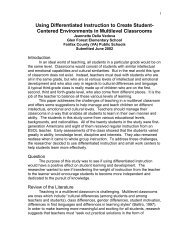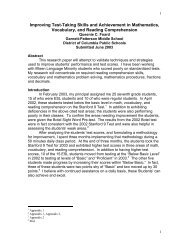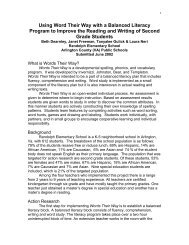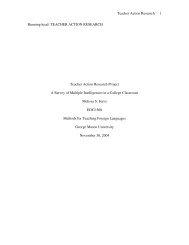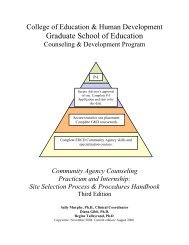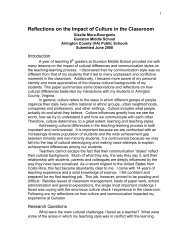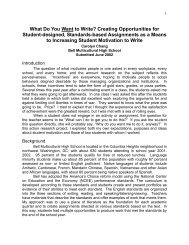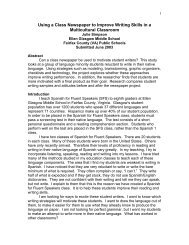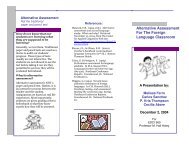What Are the Influences of Culture on the Minority Language ...
What Are the Influences of Culture on the Minority Language ...
What Are the Influences of Culture on the Minority Language ...
Create successful ePaper yourself
Turn your PDF publications into a flip-book with our unique Google optimized e-Paper software.
2<br />
speaking as she did.) When I pointed this out to her, she basically sat down and<br />
stopped talking.<br />
From that day forward, Miss D improved. She did not chatter, and she<br />
seemed to pay attenti<strong>on</strong> in class. She raised her grades from a borderline D to a<br />
C/C+. She also came in after school for extra help, which she had not d<strong>on</strong>e<br />
previously.<br />
Focus <str<strong>on</strong>g>of</str<strong>on</strong>g> My Research<br />
From <str<strong>on</strong>g>the</str<strong>on</strong>g>re, I decided to focus <strong>on</strong> a group <str<strong>on</strong>g>of</str<strong>on</strong>g> four girls in <str<strong>on</strong>g>the</str<strong>on</strong>g> same class<br />
who came from a similar cultural background as Miss D. These students were all<br />
about <str<strong>on</strong>g>the</str<strong>on</strong>g> same age, had been in <str<strong>on</strong>g>the</str<strong>on</strong>g> country roughly <str<strong>on</strong>g>the</str<strong>on</strong>g> same length <str<strong>on</strong>g>of</str<strong>on</strong>g> time,<br />
and were all from <str<strong>on</strong>g>the</str<strong>on</strong>g> same country (Vietnam), so had similar cultural<br />
backgrounds. However, in respect to <str<strong>on</strong>g>the</str<strong>on</strong>g>ir grades, <str<strong>on</strong>g>the</str<strong>on</strong>g>y were different: <str<strong>on</strong>g>the</str<strong>on</strong>g>y<br />
ranged from A to F and everything in between. I applied <str<strong>on</strong>g>the</str<strong>on</strong>g> knowledge <str<strong>on</strong>g>of</str<strong>on</strong>g> my<br />
own (Japanese) culture, and <str<strong>on</strong>g>the</str<strong>on</strong>g> knowledge <str<strong>on</strong>g>of</str<strong>on</strong>g> <str<strong>on</strong>g>the</str<strong>on</strong>g> Vietnamese culture I learned<br />
from my students with <str<strong>on</strong>g>the</str<strong>on</strong>g> express purpose <str<strong>on</strong>g>of</str<strong>on</strong>g> motivating or o<str<strong>on</strong>g>the</str<strong>on</strong>g>rwise pushing<br />
<str<strong>on</strong>g>the</str<strong>on</strong>g>se four students to do better. This was assessed through observati<strong>on</strong>, <strong>on</strong>e<strong>on</strong>-<strong>on</strong>e<br />
interviews, and surveys, in additi<strong>on</strong> to <str<strong>on</strong>g>the</str<strong>on</strong>g>ir test results and o<str<strong>on</strong>g>the</str<strong>on</strong>g>r grades.<br />
Each <str<strong>on</strong>g>of</str<strong>on</strong>g> <str<strong>on</strong>g>the</str<strong>on</strong>g> o<str<strong>on</strong>g>the</str<strong>on</strong>g>r girls in this group raised her grades as well, with <str<strong>on</strong>g>the</str<strong>on</strong>g> <strong>on</strong>e<br />
excepti<strong>on</strong> being <str<strong>on</strong>g>the</str<strong>on</strong>g> girl who had an A before <str<strong>on</strong>g>the</str<strong>on</strong>g> study began and kept it through<br />
<str<strong>on</strong>g>the</str<strong>on</strong>g> end <str<strong>on</strong>g>of</str<strong>on</strong>g> <str<strong>on</strong>g>the</str<strong>on</strong>g> year. The o<str<strong>on</strong>g>the</str<strong>on</strong>g>r girls raised <str<strong>on</strong>g>the</str<strong>on</strong>g>ir grades from an F to a C, from a<br />
D to a C, and from a C+ to a B+, respectively.<br />
The sec<strong>on</strong>d part <str<strong>on</strong>g>of</str<strong>on</strong>g> this project involved looking at certain stereotypes <str<strong>on</strong>g>of</str<strong>on</strong>g><br />
recent arrivals to this country. Asian immigrants, for example, are seen as<br />
always excelling in Math and Science, and certain Asian cultures (such as <str<strong>on</strong>g>the</str<strong>on</strong>g><br />
Japanese) are always seen to be more comfortable working in groups as<br />
opposed to individually, etc. I created a survey which I gave to my students.<br />
Findings<br />
As I reviewed <str<strong>on</strong>g>the</str<strong>on</strong>g> students’ resp<strong>on</strong>ses to <str<strong>on</strong>g>the</str<strong>on</strong>g> survey, I realized <str<strong>on</strong>g>the</str<strong>on</strong>g>y could<br />
be separated into three groups: US born students, students from o<str<strong>on</strong>g>the</str<strong>on</strong>g>r countries<br />
who had been in <str<strong>on</strong>g>the</str<strong>on</strong>g> US less than 10 years, and those who were born overseas<br />
but who spent more than 10 years in <str<strong>on</strong>g>the</str<strong>on</strong>g> US. This divisi<strong>on</strong> was chosen since<br />
students who have been in <str<strong>on</strong>g>the</str<strong>on</strong>g> US ten or more years have spent half or more <str<strong>on</strong>g>of</str<strong>on</strong>g><br />
<str<strong>on</strong>g>the</str<strong>on</strong>g>ir lives in this country and are more likely to have acculturated to American<br />
ways.<br />
The results appear below, with <str<strong>on</strong>g>the</str<strong>on</strong>g> number <str<strong>on</strong>g>of</str<strong>on</strong>g> students who resp<strong>on</strong>ded to<br />
each questi<strong>on</strong> given as a percentage <str<strong>on</strong>g>of</str<strong>on</strong>g> <str<strong>on</strong>g>the</str<strong>on</strong>g> whole. Some percentages may not<br />
add up to 100% due to rounding. In additi<strong>on</strong>, <str<strong>on</strong>g>the</str<strong>on</strong>g> percentages for Questi<strong>on</strong> 5 do<br />
not add up to 100% because more than <strong>on</strong>e answer was permitted. The results<br />
are presented in <str<strong>on</strong>g>the</str<strong>on</strong>g> following table in <str<strong>on</strong>g>the</str<strong>on</strong>g> order described above and use <str<strong>on</strong>g>the</str<strong>on</strong>g><br />
following f<strong>on</strong>t formatting: US born students’ answers (regular f<strong>on</strong>t), foreign-born<br />
students’ answers (italicized f<strong>on</strong>t), and students born overseas but who have<br />
spent more than half <str<strong>on</strong>g>the</str<strong>on</strong>g>ir lives here (underlined f<strong>on</strong>t).<br />
________________________________________________________________




